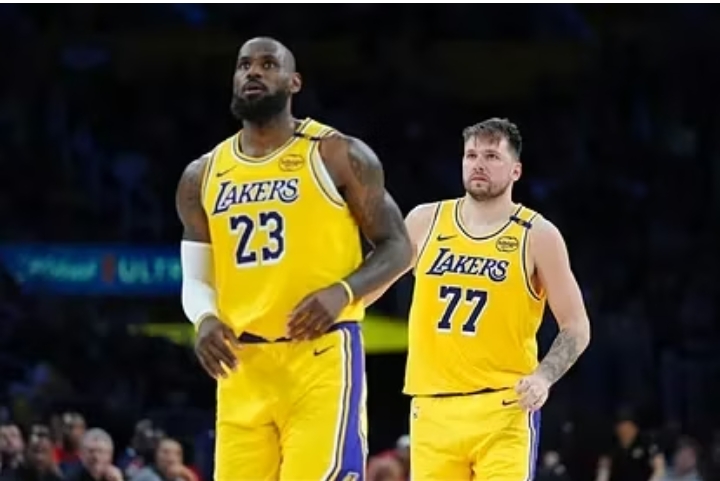THE SHOT CLOCK ticked under one second, and in an attempt that would be considered outrageous for some, and audacious for even him, Luka Doncic stepped back to evade the reach of Minnesota Timberwolves forward Jaden McDaniels’ 6-foot-11 wingspan and launched a parabola toward the Crypto.com Arena ceiling.
The ball landed softly in the net, beating the shot clock and lifting the Lakers to a one-point lead with 6:30 remaining in the fourth quarter of Game 5 on Wednesday night.
“Lu-ka! Lu-ka!” chants filled the building. Doncic sneered as he backpedaled down court, wielding his patented mix of will and savvy — even as his body was betraying him after tweaking his back during a first-half collision with Wolves guard Donte DiVincenzo.
In that instant, Doncic was the brash gunslinger for which he has become known; the Los Angeles Lakers were the team with more to prove; and Laker Nation was reminded of the feeling of unlimited hope they had that late Saturday night in early February when first hearing about one of the most shocking trades in league history.
As it turns out, it was the last glimpse of glory for the Lakers’ 2024-25 season.
It was the last shot Doncic made and the last lead L.A. held as Minnesota closed on a 16-8 run and the Lakers missed nine of their final 12 shots (with Doncic missing has last two).
The swift dissipation of momentum mirrored the Lakers’ season — and Doncic’s. No one could relate more to a seismic turn of events than him.
The changes he endured after being traded from the Dallas Mavericks to the Lakers three months ago were innumerable and all-encompassing.
The 26-year-old — a first-team All-NBA selection in each of the past five seasons — went from being a franchise icon and hopeful second coming to a one-team Hall-of-Famer, to being sent to a team built around LeBron James with a history of its own legendary stars.
It was a season of transformational change, warring narratives and rebirth.
It wasn’t all unfamiliar. Doncic did bring his Dallas pregame ritual to Los Angeles. At the conclusion of his spot shooting around the 3-point arc, Doncic launches three half-court shots. If he makes one, several Lakers assistant coaches who rebound for him have to do pushups. If he misses all three, Doncic owes the coaches body-weight squats or pushups of his own, which he completes at the center court circle.
It’s a small example of Doncic seeking comfort and routine in a season void of either. But it was a response to the whispers about him coming out of the trade — a commitment to squeezing in extra conditioning after joining the Lakers with a strained left calf that sidelined him for 5½ weeks, sources told ESPN.
His game-day routine starts at 9 a.m. with bodywork, shots, weightlifting and a cold tub plunge, sources said. Maintaining his pregame routine, fun though it is, was a sign, one source said, of Doncic recognizing the sooner he got back to peak form with his new team, the sooner the Lakers could reach their full potential.
The vision for their potential outpaced their actual performance. Wednesday night capped a disappointing five-game, first-round loss to a Minnesota team that was bigger, deeper and younger. The Lakers, in most every way, were outplayed.
Their season was, in many ways, a race against time: Doncic trying to fast-track his recovery and integration in the Lakers’ ecosystem; first-year coach JJ Redick trying to expedite his learning curve; president of basketball operations and general manager Rob Pelinka trying to revamp the roster around Doncic; and James somehow again delivering championship-level play for his team after turning 40 years old.
Time ran out to develop chemistry. Time ran out to acquire a center to both pair with Doncic and protect the rim. Time is running out on James.
“I don’t know,” James said after Game 5, when asked how much longer he’ll play. “I don’t have the answer to that.”
The Lakers entered the series as the favorites to advance. They now enter the offseason much earlier than expected — with questions and uncertainty.

